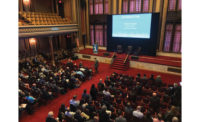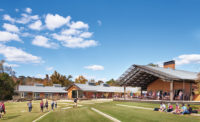A Rural Indian School Demonstrates How Government, Private Enterprise, and Good Design Can Work Together
Andhra Pradesh, India

Architects & Firms
After completing the transformation of an abandoned watch factory into a much-publicized Montessori school in its home city of Bengaluru, India, in 2014, architecture firm Collective Project received tons of inquiries for schools, says partner Eliza Higgins. Most were from for-profit institutions. Having designed one elite private school, Higgins and partner Cyrus Patell wanted more meaningful work. “Finding the right project as architects who want to have an impact is difficult, especially in education,” Higgins explains. “Schools here are typically seen as an opportunity to make money.”
The right opportunity arrived in 2016 when the Penna Foundation, a philanthropic arm of Penna Cement, one of the largest privately held cement companies in India, approached the architects with a brief to devise a prototype scheme to re-envision three existing schools, all in various stages of disrepair, built for the children of the company’s factory workers. Penna’s request—initiated through a government corporate social responsibility (CSR) mandate requiring businesses of a certain size to invest a percentage of their profits in public works—was embraced by the incoming younger generation of the family-run cement maker. Having seen Collective Project’s work for Montessori, they realized better facilities would attract better teachers, provide a higher-quality education, and ultimately be a positive force on the remote factory communities.

1
Located near the client’s factory, the school now has an entry pavilion (1), expansive bamboo shading (2), and large windows paired with jali screens (3). Photos © Benjamin Hosking (1 & 2); Vivek Eadara (3), click to enlarge.

2

3
Located in Andhra Pradesh, a hot, dry region of southern India, the 40,000-square-foot pre-K through 10th-grade Talaricheruvu Rural School is the first of these projects to be realized. According to Patell, the two-story L-shaped building was around 15 years old and sound, so its reinforced-concrete structure was maintained. Substantial revisions were necessary, however, to improve and expand its layout and systems. Bathrooms, at the perimeter of the two-acre site, were difficult to reach. The building’s 16 classrooms were too big, poorly planned, and in need of natural light and ventilation. And—due to the intense sun and heat of the region, where temperatures can exceed 109º Fahrenheit—lack of shade deterred outdoor activity.
Working with the cement factory’s engineers, the design team first cut through the building, opening it at central locations on the ground level to create a larger, more fluid area at grade. They then erected a series of pavilions to serve various functions. Two are bathrooms—one for boys, one for girls—now easily reached near each of the building’s wings and adjacent to the new open-air passageways (which double as library zones). The additional small-scale structures house an entrance with seats for waiting caregivers and bicycle parking, pre-K and kindergarten classrooms, storage, art, and multiuse spaces, and a cafeteria/teaching kitchen. (The school is also a vocational training ground for trades like cooking and carpentry.) The extant school’s interior was reworked, with 24 classrooms, two faculty lounges, and three labs on the two levels, plus more bathroom facilities on the upper floor—all punctuated by large windows and delicate jali screens to maximize daylight and airflow, and surfaced with Kadappa black limestone floors, made with the waste of stone processed in surrounding villages.
Outside, an expansive locally sourced–bamboo canopy supported by a lightweight metal framework—Collective Project’s most visually striking intervention—hovers around the perimeter of the old and new buildings and over roofless bathroom and entry pavilions, introducing shaded exterior corridors and plazas for gatherings and play that, when combined with the new structures, effectively doubles the usable space of the school’s original square footage. The firm also worked with nearby nurseries to plant pockets of local flora and trees around the grounds and on pavilion roofs, irrigating them with water from sewage treated at the neighboring factory. “Everything came from that area and was made there. Even the cement wash we used on the facade,” says Higgins.
Occupied during construction, which was largely completed in 2022, the school—with a capacity for 600 children—is still waiting for new furniture, smart-classroom equipment, and courts for sports like tennis and basketball, as well as a “learning landscape” on the roof. (At times, the architects had to share the engineers with their client. Further, the CSR funding is distributed annually, so when money ran out, work stopped until the next year.) “But, while the process has been slow,” says Patell, “the Penna Foundation didn’t cut anything. And they are already talking to us about the second school.” Higgins adds, “I think it’s just a matter of time and cash flow. And when they’re ready, we’ll be here.”
Click drawing to enlarge





